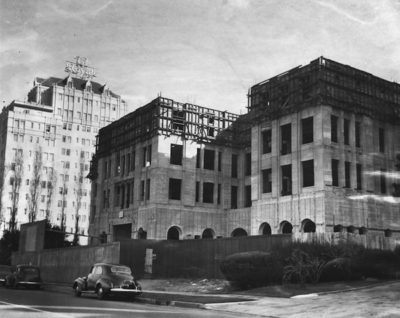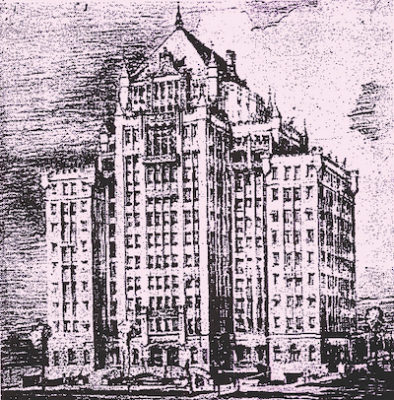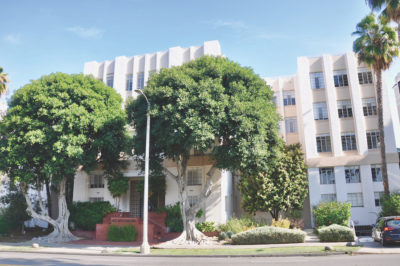Developer buys building with history of design changes

FOUR FLOORS were built before construction ended, leaving an unfinished project across from the Wilshire Country Club.
Residents of a rent-controlled apartment building in Hancock Park say they are worried about plans from the building’s new owner to evict them while the structure undergoes expansion and seismic upgrades, converting apartments into “co-living” units. The building has a long history of development twists and turns.
Located at 410 N. Rossmore Ave., the five-story building, which sits overshadowed between two historic towers — the El Royale to the north and Country Club Manor to the south — includes a fascinating history of how it came to be built, but more on that later.
“Housing some tenants for more than 30 years, the building’s fate is hanging in the balance,” resident Michelle Hodan wrote to the Chronicle. “We don’t want to lose our homes,” she pleaded.
The building’s new owner, Atlanta-based Domos Co-Living, describes itself as a “tech-enabled co-living developer” that specializes in housing that provides “affordable options in expensive areas.”
Residents were first informed of the eviction plans on Christmas Eve., when a representative from Domos called tenants to preemptively brief them on plans before the new owner closed escrow on the property in January.
According to resident Anne Roberts, the tenants are still seeking more information.
“Some of us were told by Domos that we would be relocated while the building was renovated into co-living units, and then invited back.
“But it’s unclear what we will be invited back to — who wants to live like a bunch of college kids?” said Roberts.
Co-living units generally are designed to include a private bedroom space while areas like bathrooms, kitchens and living rooms are shared with other tenants.
On questions of: which residents would be invited back; whether all units will be converted into co-living; and where the additional parking will come from, answers were not provided.
Fearing the worst, residents are seeking to have the city designate the property as a Historic-Cultural Monument, thinking that may thwart change.
Speaking to the Chronicle, Domos Construction Manager Richard Loring confirmed that the company closed escrow on the building on Jan. 17.
“There is a great deal of planning and renovation that goes into this kind of project,” explained Loring by phone.
In regard to current residents, Domos will offer to “buy out” some residents and for other residents, the company will pay for relocation, moving expenses and any difference in a higher-cost rent during the renovation period.
When asked about specific design aspects, Loring said he was unable to discuss such details at this time, but he did indicate that the company is planning “extensive work” on the property.
“The building has an interesting history,” explained Loring, who noted that the building’s foundation was first constructed in 1930 for a much bigger project. “But because it was built with concrete almost 100 years ago, it doesn’t come close to meeting modern building codes and standards.”
Building background

FRENCH GOTHIC 13-story tower by architect Max Maltzman was original design for 410 N. Rossmore Ave.
Officially completed in 1944, the building at 410 N. Rossmore is in fact older, dating back to 1930.
One year after the great Wall Street Crash of 1929, it was announced that a grand apartment building was to be built at the then-enormous cost of over $1 million for developer Harry Feigenbaum. (A Hancock Park resident himself, Feigenbaum had built his personal residence at 624 S. June St. in early 1929, according to Historic Places LA.)
Known as the “Beverly-Rossmore,” the planned 13-story apartment tower was expected to be one of the grandest structures in the west.
Iconic architect Max Maltzman (after designing the nearby Ravenswood Apartments) was tapped to design the structure in a French Gothic style. Maltzman’s plans called for 103 elegant apartments, with the 12th and 13th floors reserved for two eight-room penthouses, all situated above a series of grand public spaces on the lower floors that included a grand lobby, ballroom, lounge, billiards room and an 80-foot-long solarium, all created for the pleasure of residents, according to research by historian Steve Vaught, who has written in more detail on the building in his blog Paradise Leased.
Construction on the project began in November of 1930 even as the country’s economic outlook declined by the day. By the summer of 1931, with only four floors completed, and nearly $500,000 spent, work ground to a halt.

ARMY ENGINEERS finished the building in 1944 without the grand designs and with only five stories in an effort to ease a housing crisis during World War II.
Then, in 1937, it was announced that financing was arranged to complete the project; however, the grand 13-story French Gothic design was replaced with plans for an eight-story Streamline Deco building designed by Gilbert Stanley Underwood (architect of The Ahwahnee Hotel in Yosemite and the U.S. Courthouse in Downtown Los Angeles, among many other works). This time, it would be called the “Rossmore-Beverly.”
Soon, financing dried up for a second time, and work stopped before much progress.
In the years to come, the United States entered World War II and, as civilians and soldiers returned to war production work, Southern California soon found itself in a severe housing shortage — not unlike today. In an effort to ease the crisis, the Army Corps of Engineers took notice of 410 N. Rossmore Ave.
Reworking the four floors already built, and changing design plans, including dividing the double-height public rooms into two separate floors, the Army was able to create 78 apartments within the simple, no-nonsense five-story design seen today.
For more information on the history of 410 N. Rossmore Ave., see our previous article from August 2011.
Category: Real Estate

For twenty years, I lived in Hancock Park as a resident, neighbor, and citizen,
understanding that I had an obligation to do what was right for the greater
community. I took this obligation seriously and intended to honor my commitment,
knowing full well that doing anything less than optimal stewardship and selfless service
could be interpreted as me not appreciating the fortunate circumstances I found myself in.
Otherwise, why bother? So it’s very sad to see that a building like the one at 410 Rossmore,
like so many other historic buildings, shared the fate of being scooped up by developers,
is indicative of a trend that prioritizes profits and not the needs of the common person,
valuing money over doing the right thing. It’s incredible. I mean, seriously, who
in their right mind would do that? Not a group who cared about truly affordable housing.
Not a group of people who wanted to keep people in housing that was already affordable. Just
give the people back their building already.